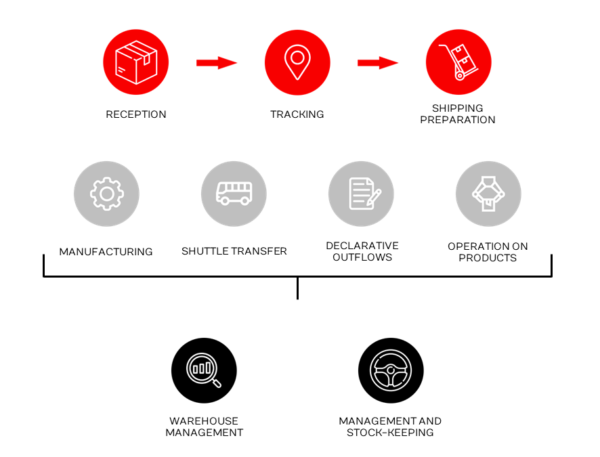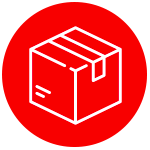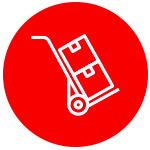1 – Scheduling
This activity consists of planning future “expected” receipts (via an ASN or an EDI purchase order), or “announced” receipts (for example by an appointment linked to a known (expected) or unknown (“wild” receipt).
A WMS software is a solution that aims to optimize and manage the physical flows and stocks within a warehouse. The term WMS is the acronym for Warehouse Management System. It is an expert, essential software package dedicated to logistics management. The WMS belongs to the list of tools related to Supply Chain Management and more globally to Enterprise Management 4.0.
The WMS covers all the problems of logistics flow management within a company. From planning, unloading, addressing, replenishment, to order preparation and shipment of deliveries.
The term WMS also echoes the notions of logistics software packages, WMS software and logistics solutions.
Deploying a WMS is an opportunity to optimize your logistics flows, reorganize your activities and optimize your practices. The implementation of a WMS allows to undertake, to reduce administrative tasks and those with no added value. Quickly deployable and with strong impacts on the logistics flows, the WMS allows to activate very consequent productivity gains and a very strong profitability of your project!
Simple, highly productive flows that are efficiently piloted by operational staff require complete, high-performance solutions that allow each process to be handled with finesse, and that take into consideration the physical constraints of your site and the logistical requirements of your products.
What is the purpose of a WMS software?
The WMS is a real logistics toolbox that can cover a wide range of processes. It is an essential and indispensable solution for having a real time vision of your logistics activity.
The WMS plays the role of an orchestra conductor to animate as harmoniously and efficiently as possible the people, the equipment and the goods inside the warehouse.
Orchestrating the resources within the framework of an economy of means, the WMS makes it possible to manage the logistics of your company, and to make sure to take the good decisions.
The WMS will allow you to manage the entire logistic flow of goods in a warehouse: from their reception and entry into the warehouse, to the management of their exit from the warehouse, while optimizing their location, stocks and internal movements.
Here is the logical or more exactly chronological order that can be found in any warehouse: entries, storage, preparation for shipment. We have also added value-added activities such as preparation for manufacturing or operations on products…
The implementation of a WMS software will allow you to manage the different key steps of the warehouse management, from the entry of the goods to their exit through their internal logistics.
The functionalities of a WMS :


This activity consists of planning future “expected” receipts (via an ASN or an EDI purchase order), or “announced” receipts (for example by an appointment linked to a known (expected) or unknown (“wild” receipt).
This involves unloading the goods WITHOUT receiving them. This makes it possible to declare the expected goods as “unloaded” and ” pending receipt “. It also allows to digitize the step of information of the CMR and to realize a first control (delay, aspect, completeness of the documents…).
This activity is a key part of the reception process and takes the form of entering or scanning reference data, or even all the properties of the article by using a barcode… or coupling with a DESADV (or ASN). The reception can then be done by a simple validation of the expectations if everything is correct!
The control aims at carrying out precise tasks associated with predefined answers. The control can lead to the setting aside of products (quarantine) or to the testing following sampling.
For pallets that cannot be used as they are (badly assembled, heterogeneous boxes, multi-lot products, etc.), a splitting operation may be necessary to reconstitute homogeneous pallets. Optionally, a labeling in reception (of the pallet by a number of SSCC, even of each article) makes it possible to identify very clearly the products to be located and thus to close the process of reception of the goods.

It is the act of putting in stock after a reception. It will allow to confront storage resources with storage needs. Putting away can be a voluntary and manual act (declarative or chaotic mode) or an automatic act according to rules. It can be carried out with or without a carriage (mono or multi references), to fixed addresses (dedicated to a reference) or to unmarked addresses.
Cross-docking (or X-Dock) consists in crossing flows (cross) on the docks (dock). It could be summarized as allowing a reservation and a picking of articles as soon as they are received in the warehouse. It thus allows the elimination of storage tasks, a shortening of delays, a reduction of stocks…
The replenishment consists in feeding the stocks located in the picking area to avoid a shortage, and this in a manual or automatic way from predefined rules (for example at the launching of an order preparation or when thresholds are crossed). The articles come either from the general stock (reserve) or directly from a reception.

The preparation of a production order makes it possible to link components with a compound via a BOM link in order to provide a preparation thus constituted to a production workshop.
The production output is used when a bill of material is unreliable or when the production of a compound has to be regularly supplemented with additional components.

Kitting is the translation in the preparation of a compound into components. It does not involve any specific packaging, assembly and therefore declaration of the compound.
It is very similar to kitting but with a more commercial (and punctual) vocation than functional.
It is a question of dressing a product with the colors of a customer or to carry out operations of labeling for a commercial operation.

When we are in a multi-site approach, the management of “shuttle flows” induces acts of picking in a site and then loading the shuttle in order to supply another site.

This is the act of removing goods from inventory regardless of external demand.

It often comes down to matching the preparation workload with the available preparation resources (staff, equipment, etc.).
Order processing includes prioritizing orders within the “good to go” orders and then putting them into preparation, tracking orders in preparation and managing anomalies.
This activity makes it possible to assign the best preparation mode to one or more sales orders simultaneously (or wave). There are preparation modes called “full order”, in “Pick By Line” (or pick), in “single order” (only one line per order), in ambulatory “Pick & Pack” with a multi-order carriage or with a pre-polished support (1 compartment per order), in “Pick then Pack” carried out either in waves (in 2 times with 1 compartment per reference) or in boxes (in 3 times) and finally preparation modes in “full container”. For the “waves”, the system allows a finer breakdown of the preparation by creating “rounds” (number of lines that a picker can pick in a single trip).
Picking is the physical act of taking goods from stock (picking) and then putting them into a package (packing) according to a predefined preparation method. The system then defines the routes of the personnel assigned to this task (“path”), as well as the presentation of the articles (sometimes with a “Pick To Light” system). Each mode is more or less adapted to a type of logistics. Value-added operations on products are possible before or after packing.
Here we find the edition of shipping documents (delivery note, packing list or packing slip, consignment note or CMR, LTA, bill of lading…), security documents (ADR, IATA…) and customs documents (CN23…). Thanks to the exchange of information with the carrier, the carrier’s discount will also be edited, and often by an EDI exchange the carrier’s label.
In the shipping areas, the act of consolidation (or reconciliation) consists of grouping several shipping media for the same carrier, or several media for the same customer or the same order. It can integrate quality control operations before loading or palletization (sometimes assisted by a “Put To Light” system).
Loading the media is the physical handing over of the media to a carrier. The CMR is then established by the carrier.

This activity aims at creating and maintaining the database (completeness, accuracy…): articles and packaging, type of identification (EAN13, EAN 128…), loads (types of containers), locations (company, sites, warehouse, stockpiles – mass or rack – associated management areas, addressing, routes…. ), third parties (customers, carriers, suppliers…), hazardous materials, staff and their qualifications, the fleet of machines (forklift…), nomenclatures…
The storage organization must comply with regulatory, productivity, safety and ergonomic constraints. To assign a reference to a location in an optimal way, many criteria are taken into account: type of storage equipment, dimensions of the cells, weight, fragility, sensitivity to theft of certain products… These criteria lead to the definition of locations (slotting) which can be single or multi references, or single or multi batches, and integrating the possibility of storage in bulk or in containers (with associated blocking).
The stock management covers manual or automatic actions of computerized corrections of stocks, entry / exit, quarantines, locks, alerts … created as a result of counts, quality controls, inventory control or by management rules of DLP / DLV, SEVESO constraints … It allows the possibility of editing stock statements accordingly, as well as the traceability of products (“tracking”) or movements (“tracing”).
Stock optimization covers calculations, analyses and actions on item rotation and stock coverage. This function allows to recalculate the A-B-C rotation and to modify for reasons of efficiency or convenience, the thresholds and quantity of replenishment. The analysis of the sales forecasts also allows to optimize the stocks by having a probabilistic approach of the coverage rates.

This activity gathers the strategies and rules applicable to the operations in reception, storage, picking, preparation, applied or not to a group of articles (commercial families, logistic families…). These rules allow an assisted control of the operator in his operations (the latter keeping the choice) or an “automatic piloting” of the tasks. The operations carried out can activate events and workflows in order to warn, for example, the purchasing department of an anomaly in reception, or the quality department in the event of a quality defect on a product.
As a WMS knows and sees almost everything, it is possible to ask it to generate status indicators (availability of locations, references with expiration dates, etc.), production monitoring (number of packages to be prepared, orders in progress, etc.), activities (number of receipts/day, articles picked, etc.), productivity (number of picks/hour), quality (prepa error rate, inventory discrepancy, etc.) or economic indicators (cost of a receipt, etc.). Grouped and presented in dashboards, it is important that they are readable and intuitive.
It includes the configuration of system accesses (user profiles and access rights, user groups, etc.), the implementation and monitoring of “Infrastructure & Equipment” connectors (storage and conveying solutions, robots, visual assistance, data capture, terminals, printers), as well as IT – Information Technology connectors (ERP, web platforms and marketplaces, TMS transport, external expert solutions)
Thanks to an analytical breakdown of warehouse activities along several axes (customer, process, product, etc.), it is possible to monitor logistics costs more effectively, identify low or high value-added activities and areas for improvement. Crucial for logistics service providers, the information collected can also be used to generate invoices for operations carried out per work unit.
Discover in detail the benefits that such a solution can bring you!